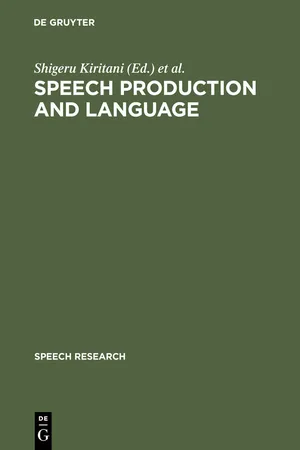
This is a test
- 312 pages
- English
- PDF
- Available on iOS & Android
eBook - PDF
Speech Production and Language
Book details
Table of contents
Citations
Frequently asked questions
At the moment all of our mobile-responsive ePub books are available to download via the app. Most of our PDFs are also available to download and we're working on making the final remaining ones downloadable now. Learn more here.
Both plans give you full access to the library and all of Perlego’s features. The only differences are the price and subscription period: With the annual plan you’ll save around 30% compared to 12 months on the monthly plan.
We are an online textbook subscription service, where you can get access to an entire online library for less than the price of a single book per month. With over 1 million books across 1000+ topics, we’ve got you covered! Learn more here.
Look out for the read-aloud symbol on your next book to see if you can listen to it. The read-aloud tool reads text aloud for you, highlighting the text as it is being read. You can pause it, speed it up and slow it down. Learn more here.
Yes, you can access Speech Production and Language by Shigeru Kiritani, Hajime Hirose, Hiroya Fujisaki in PDF and/or ePUB format, as well as other popular books in Languages & Linguistics & Linguistics. We have over one million books available in our catalogue for you to explore.
Information
Table of contents
- 1. Background
- Speech: a physicist remembers
- 2. Laryngeal functions in speech
- Male-female differences in anterior commissure angle
- Correlations among intrinsic laryngeal muscles during speech gestures
- Regulation of fundamental frequency with a physiologically-based model of the larynx
- High-speed digital image analysis of temporal changes in vocal fold vibration in tremor
- Phonetic control of the glottal opening
- 3. Voice source characteristics in speech
- Frequency domain analysis of glottal flow: The LF-model revisited
- Consequences of intonation for the voice source
- Fundamental frequency rule for English discourse
- Physiological and acoustical correlates of voicing distinction in esophageal speech
- 4. Articulatory organization
- The postalveolar fricatives of Polish
- A note on the durations of American English consonants
- Articulatory coordination and its neurobiological aspects
- Token-to-token variation of tongue-body vowel targets: The effect of context
- The phonetic realization of the haiku form in Estonian poetry, compared to Japanese
- Synthesis and coding of speech using physiological models
- 5. Verbal behavior: sound structure, information structure
- Comparison of speech sounds: distance vs. cost metrics
- A note on Japanese passives
- Sentence production and information
- Index